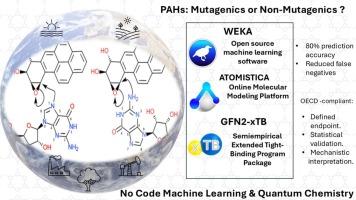可解释的无代码符合经合组织的机器学习模型,以预测多环芳烃及其自由基阳离子代谢物的致突变活性
IF 8
1区 环境科学与生态学
Q1 ENVIRONMENTAL SCIENCES
引用次数: 0
摘要
多环芳烃(PAHs)是一种持久性污染物,具有众所周知的基因毒性和诱变效应,对生态系统和人类健康构成风险。它们的疏水性促进了在土壤和水生环境中的积累,增加了暴露风险。在代谢激活后,多环芳烃产生反应性物质,形成DNA加合物,驱动其致突变潜能。本研究提出了一种符合经合组织标准的方法,该方法将GFN2-xTB级别的概念密度泛函理论(CDFT)计算与机器学习模型相结合,以预测多环芳烃的突变性。利用前致癌物和自由基阳离子代谢物的量子化学描述符以及Ames测试数据,确定了与致突变性相关的关键电子特性。特征选择一致强调自由基阳离子描述符作为代谢激活途径的关键指标。包括SPAARC、Random Tree和JCHAID在内的机器学习模型的验证准确率超过89%,假阴性率最低,确保了对环境风险评估的保守预测。PSL和CDP亲电性框架被证明在模拟DNA损伤相关过程中特别有效。这种无代码、基于免费软件的方法为评估环境相关条件下的诱变风险提供了一种可扩展且具有成本效益的工具。这些发现强化了代谢激活的重要性,验证了自由基阳离子作为这一过程的可靠代理,并证明了电子性质在QSAR建模中的预测价值。这些见解支持了环境毒理学的进步,并有助于改进监管风险评估策略。本文章由计算机程序翻译,如有差异,请以英文原文为准。

Explainable no-code OECD-compliant machine learning models to predict the mutagenic activity of polycyclic aromatic hydrocarbons and their radical cation metabolites
Polycyclic aromatic hydrocarbons (PAHs) are persistent pollutants with well-known genotoxic and mutagenic effects, posing risks to ecosystems and human health. Their hydrophobic nature promotes accumulation in soils and aquatic environments, increasing exposure risks. Upon metabolic activation, PAHs generate reactive species that form DNA adducts, driving their mutagenic potential. This study presents an OECD-compliant methodology that integrates conceptual density functional theory (CDFT) calculations at the GFN2-xTB level with machine learning models to predict PAH mutagenicity. Using quantum chemical descriptors of procarcinogens and radical cation metabolites alongside Ames test data, key electronic properties linked to mutagenicity were identified. Feature selection consistently highlighted radical cation descriptors as key indicators of metabolic activation pathways. Machine learning models — including SPAARC, Random Tree, and JCHAID — achieved validation accuracies exceeding 89 %, with minimal false-negative rates, ensuring conservative predictions for environmental risk assessment. The PSL and CDP electrophilicity frameworks proved particularly effective in modeling DNA damage-related processes. This no-code, freeware-based methodology provides a scalable and cost-effective tool for assessing mutagenic risks in environmentally relevant conditions. The findings reinforce the importance of metabolic activation, validate the radical cation as a reliable proxy for this process, and demonstrate the predictive value of electronic properties in QSAR modeling. These insights support advances in environmental toxicology and contribute to improved strategies for regulatory risk assessment.
求助全文
通过发布文献求助,成功后即可免费获取论文全文。
去求助
来源期刊

Science of the Total Environment
环境科学-环境科学
CiteScore
17.60
自引率
10.20%
发文量
8726
审稿时长
2.4 months
期刊介绍:
The Science of the Total Environment is an international journal dedicated to scientific research on the environment and its interaction with humanity. It covers a wide range of disciplines and seeks to publish innovative, hypothesis-driven, and impactful research that explores the entire environment, including the atmosphere, lithosphere, hydrosphere, biosphere, and anthroposphere.
The journal's updated Aims & Scope emphasizes the importance of interdisciplinary environmental research with broad impact. Priority is given to studies that advance fundamental understanding and explore the interconnectedness of multiple environmental spheres. Field studies are preferred, while laboratory experiments must demonstrate significant methodological advancements or mechanistic insights with direct relevance to the environment.
 求助内容:
求助内容: 应助结果提醒方式:
应助结果提醒方式:


